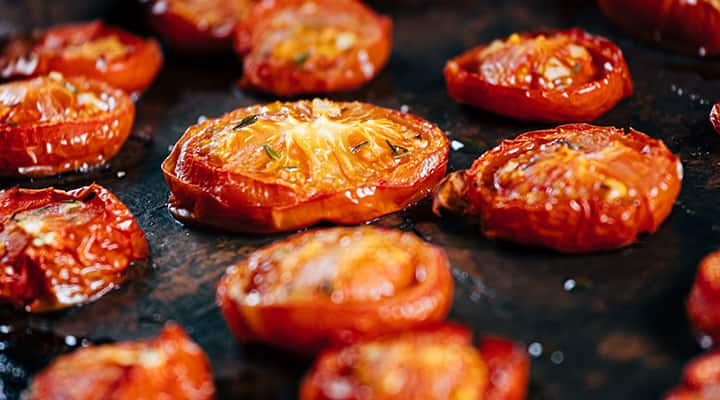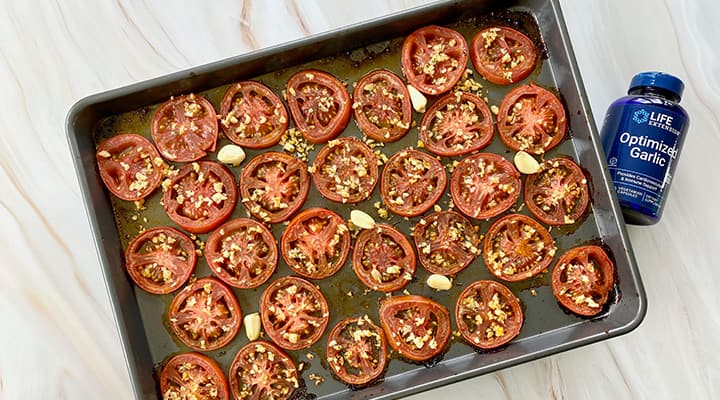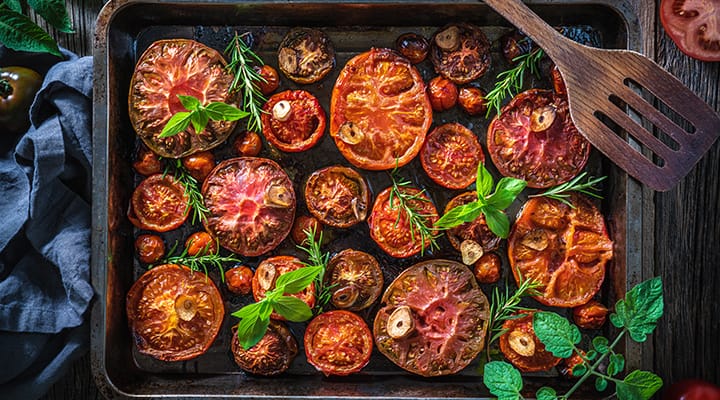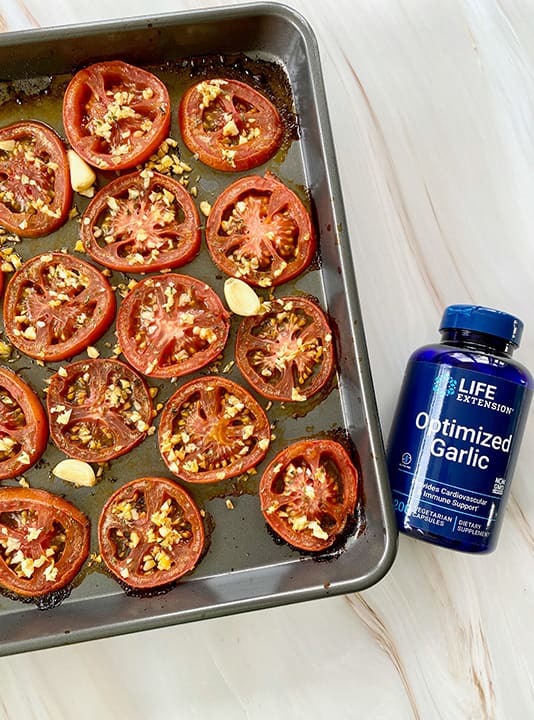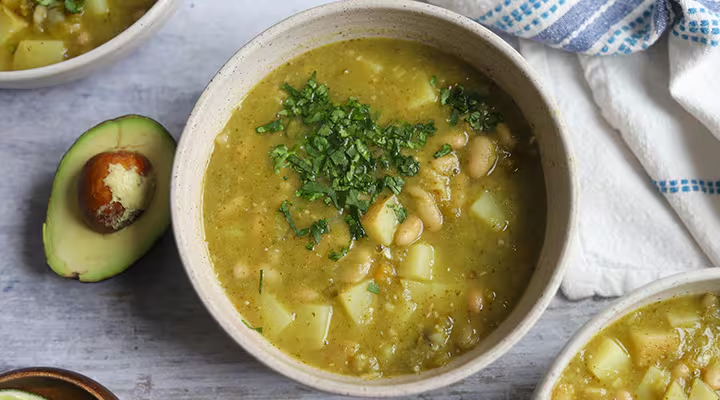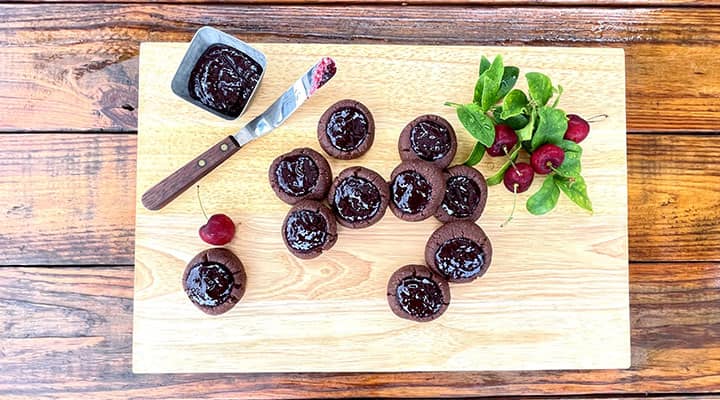
Roasted Tomatoes with Garlic: Healthy Recipe
Published: June 2022
There’s something about roasting fruits and vegetables that elevates and enhances their natural flavors. Roasted tomatoes with garlic are no exception. The subtle sweetness of tomatoes paired with the richness of garlic are combined into the most delicious duo when roasted—plus, garlic has a variety of immune supportive properties to boot.
This healthy, gluten-free recipe for oven roasted tomatoes with garlic and olive oil makes for a zesty side dish, micronutrient-rich snack, or a tasty toss-in to pasta, a rice bowl, or even an omelet!
What can I do with garlic and tomatoes?
Garlic and tomatoes are such a complimentary pair. In fact, often when I pair them together, I don’t think they should ever be apart! Not to be cliche, but their marriage is harmonious and synergistic, with distinct flavor profiles that really level up any dish. Whether you prefer low-carb dishes as part of a keto diet or you just love tomatoes, here are some ideas for dishes you can create with garlic and tomatoes:
- Bruschetta with balsamic vinegar glaze
- Roasted garlic pasta sauce
- Marinated tomatoes with Italian seasoning
- Roasted tomatoes with garlic and olive oil
- Avocado toast with tomatoes and garlic
- Baked Caprese garlic bread
- Garlic tomato focaccia bread
What do roasted tomatoes taste like?
Fresh tomatoes have flavor that is a combination of sweet, tart and tangy. Roasting in olive oil enhances these flavors. You may find some tomatoes to be extra-sweet, while other tomatoes are extra-bitter – this all depends on the amount of fructose or acid naturally found in tomatoes. Pick your perfect tomato by avoiding tomatoes with pale spots near the stem or large bruises or cracks in the skin.
Which tomatoes are best for roasting?
Red tomatoes on the vine are most often the easiest and most accessible tomatoes to locate at your local grocer. For this reason (convenience), I often prefer cooking with tomatoes on the vine. Cherry tomatoes or grape tomatoes are a great alternative, as you can roast them whole, and they maintain their juiciness in every bite (versus whole tomatoes that you would slice to roast).
Other types of tomatoes that are very flavorful and would be easy to slice and roast are heirloom tomatoes, green tomatoes, or Campari tomatoes.
What to eat with roasted tomatoes?
As delicious as oven roasted tomatoes with garlic are as a standalone snack or appetizer, they pair beautifully with salad and pasta (especially with a non-tomato based sauce), steak, chicken, or a seafood dish if you prefer a Mediterranean diet. The flavor profile of the roasted tomatoes really complements these main dishes, which won’t need a heavy sauce or seasonings with roasted tomatoes with garlic as a side dish.
Tomatoes recipe: How to make roasted tomatoes with garlic
Ingredients:
- 5 red tomatoes on the vine
- 10 cloves of garlic
- 1 tbsp extra virgin olive oil
- ½ tsp black pepper
- 2 tsp dried oregano
Preparation:
- Pre-heat oven to 425 degrees Fahrenheit.
- Slice tomatoes into ¼” slices and place in a single layer on baking sheet.
- Top with garlic cloves.
- Drizzle with olive oil or extra virgin olive oil and season with pepper and dried oregano.
- Roast tomatoes and garlic in oven for 15 minutes.
Nutritional Facts:
Total Servings: 4
Nutrition facts per serving:
Calories: 80 calories
Protein: 2 grams
Carbohydrates: 9 grams
Fat: 4 grams
All nutritional information is based on third-party calculations and is only an estimate. Each recipe and nutritional value will vary depending on the brands you use, measuring methods and portion sizes.
Tips for success
You’ll know your tomatoes are perfectly roasted when the edges are slightly browned and the garlic is slightly softened. Another great tip for success is doubling the ingredients above and making twice the batch – this will grant you extra oven roasted tomatoes that you can turn into a variety of delicious creations (sauce, soup, or even a dip).
For a twist on this easy recipe, use fresh herbs for seasoning or pair with a pesto for added flavor.
Explore Our Best Heart Health Supplements
Can you roast canned tomatoes?
While fresh tomatoes yield a delicious burst of flavor, roasting canned tomatoes takes them from tasting a bit bland and acidic to sweet and caramelized. When roasting canned tomatoes, you’ll want to drain all of the juices and follow the recipe above with a longer cooking time (since the tomatoes have been sitting in a liquid, it will take longer for them to roast).
Can you roast old tomatoes?
If you realize you have tomatoes in your kitchen that you forgot to use, no fear! As long as you aren’t seeing any mold or darkened spots, you can absolutely roast softened tomatoes (especially because they won’t taste as crisp as if you were eating them fresh). Tomatoes that are slightly softened may not be as easy to slice as fresh tomatoes. You can roast them by cutting them in half or in quarters and baking for a slightly longer total time, since they won’t roast as quickly as thinly sliced tomatoes.
What is the best temperature to roast tomatoes?
Vegetables are best roasted at a high temperature (at least 400 degrees Fahrenheit). This allows for vegetables to be slightly crispy on the outside but still tender on the inside (and for tomatoes to still maintain some juiciness without being completely dried out).
How to tell when tomatoes are ready to eat
Picking the perfect tomatoes from the store can be a lot like picking the best avocado or watermelon – you learn various tips and tricks, but you never really know if you’ve picked the best one until you take a bite.
The best fresh tomatoes are ready to be eaten when they are bright red in color (versus pale pink or even green) and when they are slightly firm but give way to touch. A tomato that is unripe is very firm, and a too-ripe tomato is very soft instead of just tender.
Can you freeze roasted tomatoes?
You can absolutely freeze roasted tomatoes up to 4-5 months. However, freezing your roasted tomatoes and eating them as-is likely won’t offer the same crispy but juicy texture as roasted tomatoes fresh out of the oven. For this reason, it’s recommended you freeze your roasted tomatoes with the intention of using them in a recipe once you thaw them (because you’ll be freezing them with the roasted garlic, too – yum)! Homemade roasted tomato sauce, tomato basil soup, or hummus are scrumptious creations that would work great with roasted tomatoes that have been previously frozen in a freezer-safe container.
How long do roasted tomatoes last in the fridge?
Roasted tomatoes can be stored in an airtight container in the refrigerator for up to five days. You’ll want to ensure the tomatoes are cooled completely before storing them (whether you’re storing them in the refrigerator or freezer).
Are roasted tomatoes with garlic good for you?
Both tomatoes and garlic offer a variety of health benefits. Nutrients in tomatoes have been shown to fight oxidative stress and promote a healthy inflammatory response. A key nutritional element of tomatoes is lycopene, which has been shown to promote prostate and cardiovascular health. Tomatoes provide other antioxidants such as vitamin C, potassium, iron and folate. With all of the micronutrients and antioxidants packed in tomatoes, the profound health benefits of tomatoes include support for the immune system, gut microbiome, skin health and exercise recovery.
My roasted tomatoes recipe provides a simple and flavorful way for you to eat tomatoes and incorporate them into your daily intake of fruits and vegetables.
Health benefits of garlic
Just as powerful as the health benefits of tomatoes, garlic has been used in traditional health regimens for a long time. Studies show that allicin (found in garlic) encourages your immune system response and supports healthy platelet function. Earliest uses of garlic were usually for gastrointestinal relief, yet we know that garlic (because of allicin) has many other health benefits, such as supporting cardiovascular health and cellular detoxification.
Do you get enough garlic from this recipe?
Because of the immense immune-supportive and antioxidant properties of garlic, it’s recommended to supplement beyond the few grams of garlic you’ll be eating in a typical dish. Garlic in this recipe provides an enhancement of flavor paired with the tomatoes. But for optimal health, supplementing with garlic is a better choice.
For additional immune support, there are a variety of Life Extension® formulas for seasonal support, nasal support and general immune support. Need help picking one? Life Extension’s immune health quiz might help!
References
- Collins, Edward J. et al. “Tomatoes: An Extensive Review of the Associated Health Impacts of Tomatoes and Factors That Can Affect Their Cultivation.” Biology (Basel), February 2022, https://www.ncbi.nlm.nih.gov/pmc/articles/PMC8869745/
- Mikkelsen, R.L. “Tomato Flavor and Plant Nutrition: A Brief Review.” Better Crops, 2005, https://ucanr.edu/sites/nm/files/76647.pdf
- White, Danielle. “Healthy Uses for Garlic.” Nurs Clin North Am., March 2021, https://pubmed.ncbi.nlm.nih.gov/33549282/
Like what you read?
Please subscribe to get email updates on this blog.


